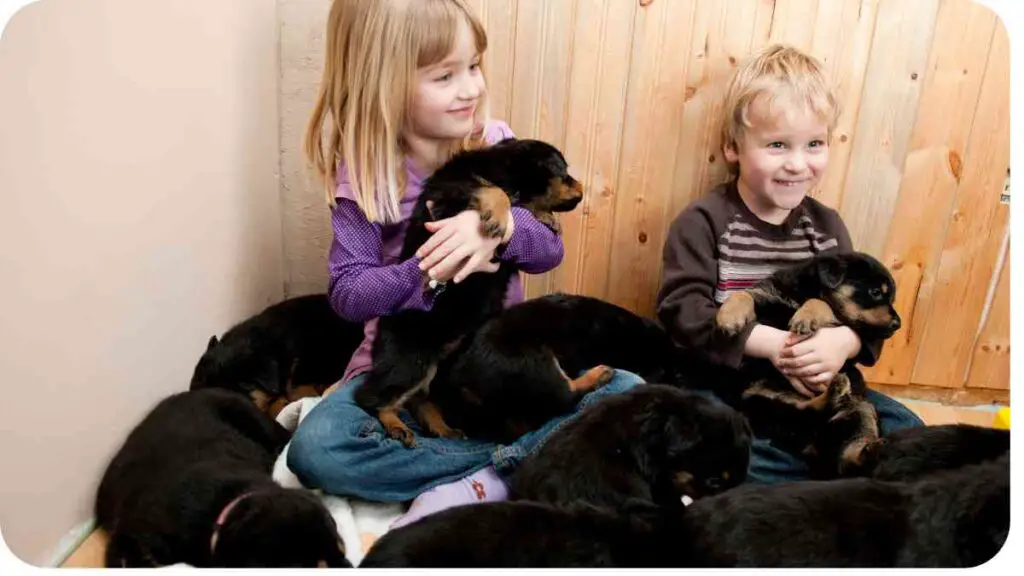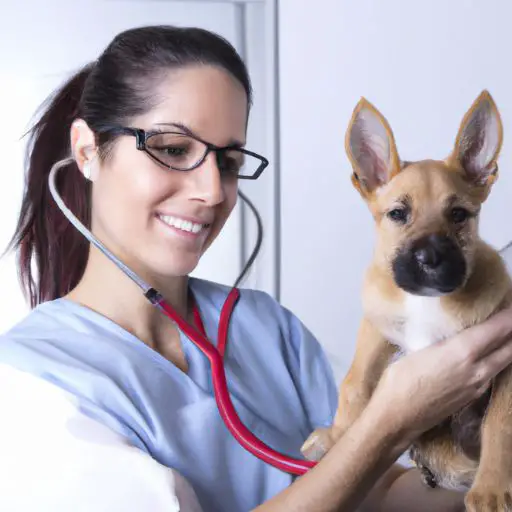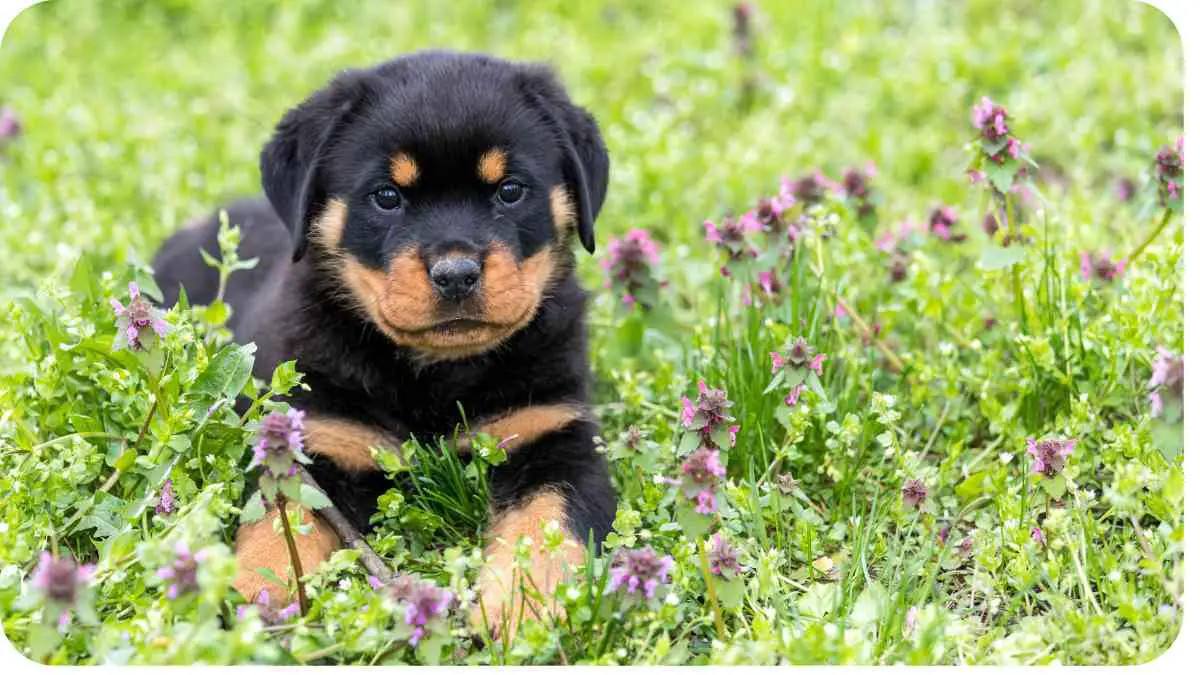Bringing home a Rottweiler puppy is an exciting experience, but it also comes with great responsibility. Rottweilers are intelligent, loyal, and affectionate dogs, but they require proper care and training to become well-behaved companions. In this ultimate guide, we’ll cover everything you need to know to raise a Rottweiler puppy successfully.
| Takeaways |
|---|
| 1. Start early: Begin socializing your Rottweiler puppy as soon as you bring them home to ensure they grow into a well-adjusted adult dog. |
| 2. Gradual exposure: Introduce your puppy to new people, animals, environments, and experiences gradually and positively to build their confidence. |
| 3. Positive reinforcement: Use treats, praise, and rewards to reinforce good behavior during socialization sessions and make the experience enjoyable for your puppy. |
| 4. Consistency is key: Be consistent in your approach to socialization, and continue exposing your puppy to new experiences throughout their life to maintain their social skills. |
| 5. Seek professional help: If you encounter challenges or behavior issues during socialization, don’t hesitate to seek guidance from a professional dog trainer or behaviorist. |
2. Understanding Rottweiler Puppies

Before diving into the specifics of raising a Rottweiler puppy, it’s essential to understand their breed characteristics. Rottweilers are large, powerful dogs with a natural instinct to protect their family. They are known for their confidence, courage, and intelligence. However, they can also be stubborn and dominant if not properly trained and socialized from an early age.
Delve into the rich history and origins of the Perro Rottweiler Breed. Learn about its fascinating journey from its ancient roots to its modern-day role as a beloved companion and guardian. Explore the unique characteristics and traits that define this iconic breed.” Perro Rottweiler Breed
Rottweiler Puppy Characteristics Table
| Characteristic | Description |
|---|---|
| Size | Large |
| Temperament | Loyal, Protective, Intelligent |
| Exercise Needs | High |
| Grooming Requirements | Moderate |
Understanding these characteristics will help you tailor your approach to raising and caring for your Rottweiler puppy.
3. Preparing Your Home for a Rottweiler Puppy
Welcoming a Rottweiler puppy into your home requires some preparation to ensure their safety and comfort. Here’s a checklist of things to do before bringing your puppy home:
Preparing Your Home Checklist
| Item | Description |
|---|---|
| Secure Your Space | Rottweiler puppies are curious and energetic, so make sure your home is puppy-proofed. Secure electrical cords, remove toxic plants, and put away small objects that could be swallowed. Consider using baby gates to restrict access to certain areas. |
| Create a Safe Space | Set up a cozy crate or bed where your puppy can rest and feel secure. Make sure it’s in a quiet area of your home and away from drafts. |
| Stock Up on Supplies | Purchase essential supplies such as food and water bowls, a collar and leash, toys, grooming tools, and a quality puppy food recommended by your veterinarian. |
| Establish a Routine | Rottweiler puppies thrive on routine, so establish a feeding, potty, and exercise schedule from day one. Consistency is key to successful puppy training. |
| Find a Veterinarian | Research and select a reputable veterinarian who specializes in caring for Rottweilers. Schedule a wellness check-up for your puppy soon after bringing them home. |
| Prepare for Training | Familiarize yourself with positive reinforcement training techniques and enroll your puppy in a puppy kindergarten class or obedience training program. Training is crucial for shaping your Rottweiler’s behavior and building a strong bond with them. |
By preparing your home and establishing a routine before your Rottweiler puppy arrives, you’ll set them up for a smooth transition and a happy, healthy life with your family.
Unlock the secrets to successful Rottweiler training with our comprehensive guide. Discover 10 Essential Tips that will help you build a strong bond with your Rottie while fostering obedience and good behavior. Transform your Rottweiler into a well-behaved and well-adjusted family member.” 10 Essential Tips
4. Feeding Your Rottweiler Puppy

Proper nutrition is essential for the healthy growth and development of your Rottweiler puppy. Here’s what you need to know about feeding them:
Rottweiler Puppy Feeding Guidelines
| Age | Frequency | Amount |
|---|---|---|
| 8-12 weeks | 4 meals per day | 1/2 to 1 cup per meal |
| 3-6 months | 3 meals per day | 1 to 1 1/2 cups per meal |
| 6-12 months | 2 meals per day | 1 1/2 to 2 cups per meal |
Note: These are general guidelines. Adjust portion sizes based on your puppy’s individual needs and activity level.
Choosing the Right Puppy Food
Selecting a high-quality puppy food is crucial for meeting your Rottweiler’s nutritional requirements. Look for a formula specifically designed for large breed puppies to support their healthy bone and joint development. Avoid foods with artificial additives, fillers, and by-products.
Feeding Tips
- Stick to a Schedule: Feed your puppy at the same times each day to establish a routine.
- Monitor Portion Sizes: Overfeeding can lead to rapid growth and potential joint problems in large breed puppies. Use measuring cups to ensure you’re offering the correct portion sizes.
- Avoid Free Feeding: Resist the temptation to leave food out all day for your puppy to graze on. This can contribute to overeating and weight gain.
- Transition Gradually: If switching to a new food, do so gradually over the course of 7-10 days to prevent digestive upset.
- Provide Fresh Water: Always have clean, fresh water available for your puppy to drink.
Signs of a Healthy Diet
- Bright eyes
- Shiny coat
- Healthy weight gain
- Regular bowel movements
- High energy levels
If you have any concerns about your Rottweiler puppy’s diet or nutritional needs, consult with your veterinarian for personalized recommendations. With the right diet, your puppy will grow into a strong, healthy adult Rottweiler.
Gain insights into the complex and dynamic temperament of the Rottweiler breed. Understand what sets these magnificent dogs apart and what to expect as a Rottweiler owner. Navigate the joys and challenges of Rottweiler ownership with confidence and knowledge.” Understanding Rottweiler Temperament
5. Training Your Rottweiler Puppy
Training is a fundamental aspect of raising a well-behaved Rottweiler puppy. Here’s how to approach training your furry companion:
Basic Training Commands
Teaching your Rottweiler puppy basic commands lays the foundation for good behavior and communication. Start with these essential commands:
- Sit: Hold a treat above your puppy’s nose and slowly move it back over their head. As they follow the treat, their bottom will naturally lower into a sitting position. Say “sit” as soon as their bottom touches the ground, then reward them with the treat.
- Stay: Begin by asking your puppy to sit. Hold out your hand like a stop sign and say “stay” in a firm but calm voice. Take a step back and wait a few seconds before returning to reward them.
- Come: Use a happy tone of voice and crouch down to your puppy’s level. Say their name followed by “come” and encourage them to approach you. Reward them generously when they reach you.
- Down: Start with your puppy in a sitting position. Hold a treat in front of their nose and slowly lower it to the ground between their front paws. Say “down” as they follow the treat, then reward them once they’re lying down.
- Leave It: Show your puppy a treat in one hand and say “leave it” as you close your fist around it. Wait for them to lose interest in trying to get the treat, then praise and reward them with a different treat from your other hand.
Training Tips
- Be Consistent: Use the same commands and techniques every time you train your puppy to avoid confusion.
- Keep Sessions Short: Rottweiler puppies have short attention spans, so keep training sessions brief (5-10 minutes) and end on a positive note.
- Use Positive Reinforcement: Reward good behavior with treats, praise, and affection. Avoid punishment-based training methods, as they can damage your puppy’s trust and confidence.
- Socialize Early: Expose your puppy to various people, animals, and environments from a young age to help them develop into a well-adjusted adult dog.
- Seek Professional Help: If you’re struggling with training or behavior issues, don’t hesitate to seek guidance from a professional dog trainer or behaviorist.
By investing time and effort into training your Rottweiler puppy, you’ll establish a strong bond built on trust and mutual respect. Remember to be patient, consistent, and positive throughout the training process.
6. Socializing Your Rottweiler Puppy

Socialization is crucial for Rottweiler puppies to develop into well-rounded and confident adult dogs. Here’s how to socialize your puppy effectively:
Debate between the Rottweiler and German Shepherd breeds to determine which is the ideal fit for your lifestyle. Explore their differences in temperament, trainability, and suitability as family pets. Make an informed decision to welcome the perfect furry companion into your home.” Rottweiler vs. German Shepherd
Why Socialization Matters
Early socialization exposes your Rottweiler puppy to different people, animals, environments, and stimuli, helping them feel comfortable and confident in various situations. Proper socialization can prevent fear-based aggression and anxiety-related behaviors later in life.
Socialization Checklist
Follow these steps to socialize your Rottweiler puppy:
- Start Early: Begin socializing your puppy as soon as you bring them home, ideally between 3 and 14 weeks of age when they are most receptive to new experiences.
- Expose Them Gradually: Introduce your puppy to new people, including adults, children, and strangers, in a controlled and positive manner. Encourage gentle interactions and provide treats and praise for calm behavior.
- Meet Other Dogs: Arrange playdates with well-behaved, vaccinated dogs to teach your puppy appropriate canine social skills. Monitor their interactions closely and intervene if necessary to prevent rough play.
- Visit Different Environments: Take your puppy on outings to various places such as parks, pet stores, and busy streets to expose them to different sights, sounds, and smells. Gradually increase the level of stimulation as your puppy becomes more confident.
- Positive Reinforcement: Use treats, toys, and praise to reward your puppy for confident and relaxed behavior in new situations. Avoid coddling or comforting them if they show signs of fear, as this can reinforce anxiety.
- Observe Body Language: Learn to read your puppy’s body language and intervene if they show signs of discomfort or stress, such as cowering, trembling, or excessive panting.
- Enroll in Puppy Classes: Consider enrolling your puppy in a puppy kindergarten class or obedience training program where they can interact with other puppies in a controlled environment under the guidance of a professional trainer.
- Continue Socialization: Socialization is an ongoing process that should continue throughout your Rottweiler’s life. Continue exposing them to new experiences and environments to maintain their social skills and confidence.
Socialization Success Table
| Socialization Experience | Success Outcome |
| Meeting new people | Confident and friendly interactions |
| Interacting with other dogs | Playful and appropriate behavior |
| Exploring new environments | Curious and relaxed, showing interest in surroundings |
| Handling by strangers | Comfortable and cooperative during grooming and vet visits |
By following these socialization guidelines and exposing your Rottweiler puppy to a wide range of positive experiences, you’ll help them grow into a well-adjusted and sociable adult dog.
Ensure your Rottweiler’s well-being with expert advice on health, nutrition, and exercise. Discover Caring for Your Rottweiler, a comprehensive resource that covers everything from dietary requirements to exercise routines. Keep your Rottie happy, healthy, and thriving for years to come.” Caring for Your Rottweiler
7. Exercising Your Rottweiler Puppy
Regular exercise is essential for the physical and mental well-being of your Rottweiler puppy. Here’s how to provide them with the right amount and type of exercise:
Exercise Needs of Rottweiler Puppies
Rottweilers are active and energetic dogs that require plenty of exercise to stay healthy and happy. Adequate exercise helps prevent obesity, boredom, and destructive behaviors.
Exercise Guidelines
Follow these guidelines when exercising your Rottweiler puppy:
- Start Slow: Begin with short, low-impact activities, such as short walks or play sessions in the backyard, and gradually increase the duration and intensity as your puppy grows.
- Structured Walks: Take your puppy for structured walks on a leash to help them learn leash manners and provide mental stimulation. Aim for at least 20-30 minutes of walking per day, divided into multiple sessions.
- Interactive Play: Engage your puppy in interactive games such as fetch, tug-of-war, or hide-and-seek to burn off excess energy and strengthen your bond.
- Puppy Playdates: Arrange playdates with other vaccinated puppies to allow your puppy to socialize and burn off energy in a safe and controlled environment.
- Mental Stimulation: Provide puzzle toys, interactive feeders, and training sessions to keep your puppy’s mind active and prevent boredom.
- Avoid Overexertion: Be mindful not to over-exercise your puppy, especially during hot weather or if they’re showing signs of fatigue. Allow them to rest and recover as needed.
Exercise Safety Tips
Ensure your Rottweiler puppy stays safe during exercise:
- Watch for Signs of Overheating: Rottweilers are prone to overheating, especially in hot weather. Watch for signs of overheating such as excessive panting, drooling, or lethargy, and provide plenty of water and shade.
- Protect Their Joints: Avoid high-impact activities such as jumping or running on hard surfaces, as this can strain your puppy’s developing joints. Stick to soft surfaces like grass or dirt when possible.
- Supervise Outdoor Activities: Always supervise your puppy during outdoor activities to prevent them from getting into hazardous situations or ingesting harmful objects.
- Consult Your Vet: If you have any concerns about your puppy’s exercise needs or limitations, consult with your veterinarian for personalized advice.
By providing your Rottweiler puppy with regular, appropriate exercise, you’ll help them stay physically and mentally healthy while strengthening your bond through shared activities.
8. Grooming Your Rottweiler Puppy
Proper grooming is essential for maintaining the health and appearance of your Rottweiler puppy. Here’s how to keep them looking and feeling their best:
Grooming Schedule
Follow this grooming schedule to keep your Rottweiler puppy clean and well-groomed:
- Brushing: Brush your puppy’s coat 2-3 times per week to remove loose fur, dirt, and debris. Use a slicker brush or grooming mitt to gently brush in the direction of hair growth, paying attention to areas prone to matting such as behind the ears and under the legs.
- Bathing: Bathe your puppy as needed, typically every 6-8 weeks or when they become dirty or smelly. Use a mild dog shampoo formulated for puppies and rinse thoroughly to remove all soap residue.
- Nail Trimming: Trim your puppy’s nails every 2-4 weeks to prevent them from becoming too long and causing discomfort or difficulty walking. Use a pair of dog nail clippers to trim the tips of the nails, being careful not to cut into the quick (the sensitive tissue inside the nail).
- Ear Cleaning: Check your puppy’s ears regularly for signs of dirt, wax buildup, or infection. Clean their ears with a veterinarian-approved ear cleaner and cotton balls or pads, being careful not to insert anything into the ear canal.
- Dental Care: Start a dental care routine early by brushing your puppy’s teeth daily with a dog-specific toothbrush and toothpaste. This helps prevent tartar buildup, gum disease, and bad breath.
Grooming Supplies
Stock up on the following grooming supplies for your Rottweiler puppy:
- Slicker brush or grooming mitt
- Dog shampoo formulated for puppies
- Dog nail clippers
- Ear cleaner
- Cotton balls or pads
- Dog-specific toothbrush and toothpaste
Professional Grooming
Consider taking your Rottweiler puppy to a professional groomer for occasional grooming sessions, especially if you’re not comfortable performing certain tasks such as nail trimming or hair clipping. A professional groomer can also provide breed-specific grooming services such as de-shedding and coat trimming.
Bonding Time
Grooming provides an excellent opportunity to bond with your Rottweiler puppy and build trust and rapport. Make grooming sessions enjoyable by offering treats, praise, and plenty of affection. Keep the experience positive and rewarding to ensure your puppy looks forward to grooming time.
By following a regular grooming routine and providing your Rottweiler puppy with the care they need, you’ll help them look and feel their best while strengthening your bond as companions.
9. Health Care for Your Rottweiler Puppy
Maintaining your Rottweiler puppy’s health is vital for their well-being and longevity. Here’s how to provide them with the necessary health care:
Veterinary Care
Regular veterinary check-ups are essential for monitoring your puppy’s health and addressing any potential issues early on. Schedule wellness exams every 6-12 months, or as recommended by your veterinarian, to ensure your puppy is growing and developing normally.
Vaccinations
Ensure your Rottweiler puppy receives the necessary vaccinations to protect them from common infectious diseases. Core vaccines for puppies typically include:
- Distemper
- Parvovirus
- Hepatitis
- Parainfluenza
Your veterinarian may also recommend additional vaccines based on your puppy’s lifestyle and risk factors.
Parasite Prevention
Protect your puppy from parasites such as fleas, ticks, and intestinal worms by following a regular preventive care regimen. Use flea and tick preventives recommended by your veterinarian, and administer monthly heartworm preventives to protect against heartworm disease.
Spaying or Neutering
Discuss spaying or neutering with your veterinarian to determine the best timing for your Rottweiler puppy. Spaying (for females) or neutering (for males) not only prevents unwanted litters but also offers health benefits such as reducing the risk of certain reproductive cancers.
Dental Care
Maintain your puppy’s dental health by providing regular dental care at home and scheduling professional dental cleanings as needed. Brush your puppy’s teeth daily with a dog-specific toothbrush and toothpaste, and offer dental chews or toys to help reduce plaque and tartar buildup.
Monitoring for Signs of Illness
Stay vigilant for signs of illness or discomfort in your Rottweiler puppy, including:
- Lethargy
- Loss of appetite
- Vomiting or diarrhea
- Difficulty breathing
- Lameness or limping
- Changes in behavior or temperament
If you notice any concerning symptoms, contact your veterinarian promptly for evaluation and treatment.
Health Insurance
Consider investing in pet health insurance to help cover the costs of unexpected veterinary expenses. Pet insurance can provide peace of mind knowing that your puppy’s medical needs will be taken care of without financial strain.
By prioritizing your Rottweiler puppy’s health care needs and partnering with your veterinarian to provide comprehensive care, you’ll set them up for a lifetime of health and happiness.
10. Common Rottweiler Puppy Problems
While Rottweilers are generally healthy and robust dogs, they may encounter some common health issues. Here are a few problems to be aware of and how to address them:
Hip Dysplasia
Hip dysplasia is a hereditary condition that affects the hip joints, causing pain, stiffness, and mobility issues. To help prevent hip dysplasia, choose a reputable breeder who screens their breeding dogs for hip dysplasia and other genetic conditions. Providing your puppy with a balanced diet, maintaining a healthy weight, and avoiding excessive exercise during growth stages can also reduce the risk of developing hip dysplasia.
Osteochondrosis Dissecans (OCD)
OCD is a developmental joint disorder that commonly affects large and giant breed puppies like Rottweilers. It occurs when cartilage fails to develop properly, leading to the formation of abnormal joint surfaces. Symptoms include lameness, joint pain, and swelling. Treatment may involve rest, medication, physical therapy, or surgery, depending on the severity of the condition.
Bloat
Bloat, also known as gastric dilatation-volvulus (GDV), is a life-threatening condition that occurs when a dog’s stomach fills with gas and twists on itself. Rottweilers are considered a deep-chested breed, making them more susceptible to bloat. To reduce the risk of bloat, feed your puppy smaller, frequent meals, avoid strenuous exercise immediately after eating, and consider feeding from a raised food bowl. If you suspect your puppy is experiencing bloat, seek emergency veterinary care immediately.
Allergies
Rottweilers can develop allergies to various environmental triggers, such as pollen, dust mites, or certain foods. Allergy symptoms may include itching, scratching, chewing on paws, ear infections, or skin infections. Work with your veterinarian to identify and manage your puppy’s allergies through dietary changes, allergy testing, and allergen avoidance strategies.
Behavioral Issues
Rottweilers are intelligent and strong-willed dogs that require consistent training and socialization from an early age. Without proper guidance, they may exhibit undesirable behaviors such as aggression, dominance, or destructiveness. Positive reinforcement training techniques, early socialization, and providing outlets for mental and physical stimulation can help address and prevent behavioral problems in Rottweiler puppies.
Conclusion
While Rottweiler puppies may encounter some health and behavioral challenges, proactive care, regular veterinary check-ups, and attentive training can help minimize these issues and ensure a happy and healthy life for your furry companion. By staying informed and proactive, you can provide your Rottweiler puppy with the best possible care and support their overall well-being.
Further Reading
- Royvon Rottweiler Training: Explore comprehensive training resources specifically tailored for Rottweiler owners, including obedience training, behavior modification, and socialization tips.
- Guide: How to Train a Rottweiler Puppy: This blog post offers a step-by-step guide to training your Rottweiler puppy, covering basic commands, socialization techniques, and behavior management strategies.
- Rottweiler Training Guide: Discover a detailed training guide designed specifically for Rottweiler owners, featuring expert advice on obedience training, leash walking, and problem-solving.
FAQs
Are Rottweilers good family dogs?
Rottweilers can be excellent family dogs when properly trained and socialized from a young age. They are loyal, affectionate, and protective of their families.
How much exercise do Rottweiler puppies need?
Rottweiler puppies require regular exercise to stay healthy and happy. Aim for at least 30-60 minutes of physical activity per day, including walks, playtime, and mental stimulation.
Do Rottweilers shed a lot?
Yes, Rottweilers are moderate shedders and will require regular grooming to manage shedding. Brushing their coat 2-3 times per week can help minimize loose fur and keep their coat healthy.
Are Rottweilers prone to health problems?
Like all breeds, Rottweilers can be prone to certain health issues, including hip dysplasia, bloat, and allergies. Working with a reputable breeder and providing proper veterinary care can help minimize these risks.
How do I socialize my Rottweiler puppy?
Socializing your Rottweiler puppy involves exposing them to various people, animals, environments, and experiences in a positive and controlled manner. Early and consistent socialization can help prevent behavior problems and ensure your puppy grows into a well-adjusted adult dog.

I’m Dr. Hellen James, I’ve spent my career working with dogs, and I’ve seen first-hand how important it is to understand the individual needs of each breed. I want to share my knowledge of dog breeds with you so that you can make informed decisions about which dog will be best for your household and lifestyle.

